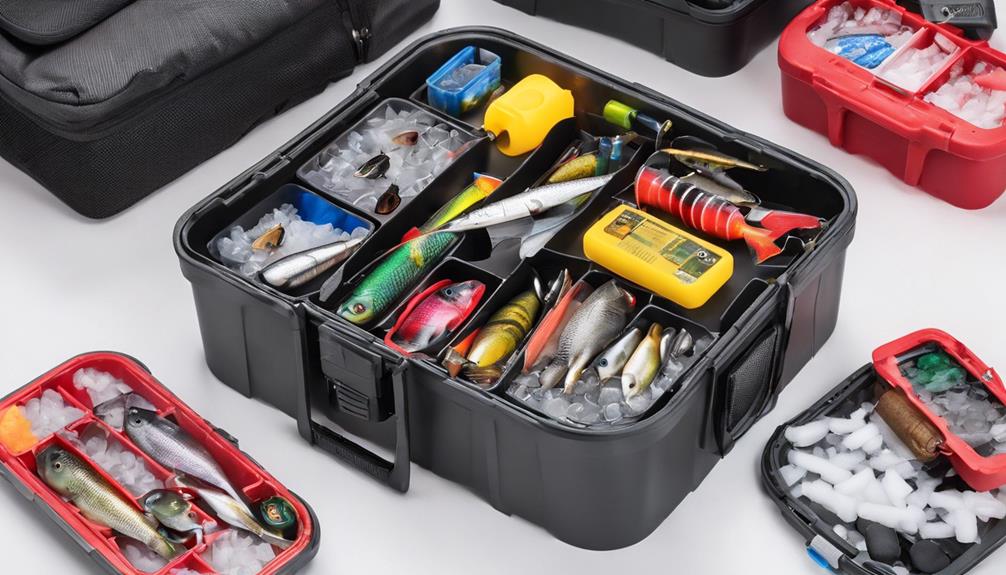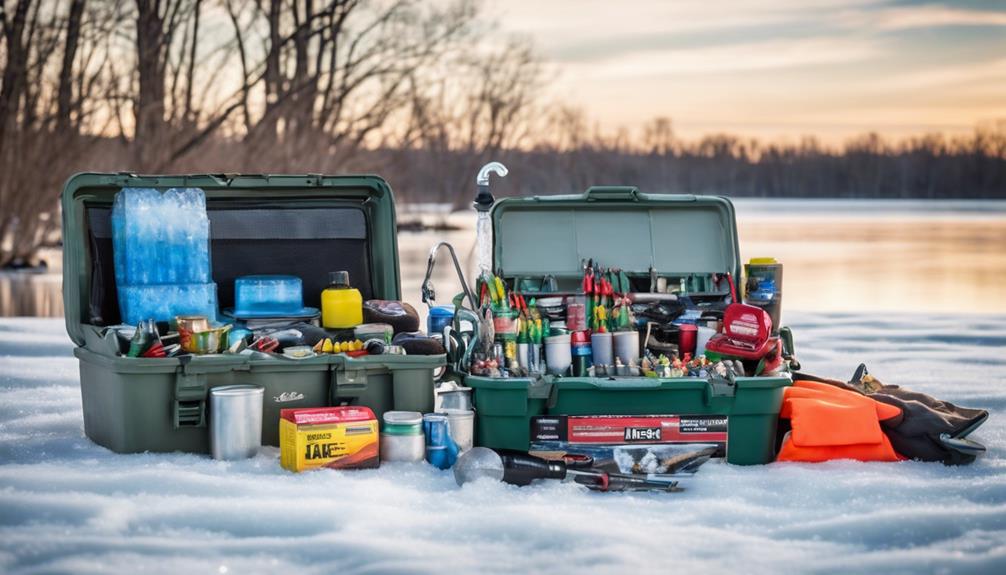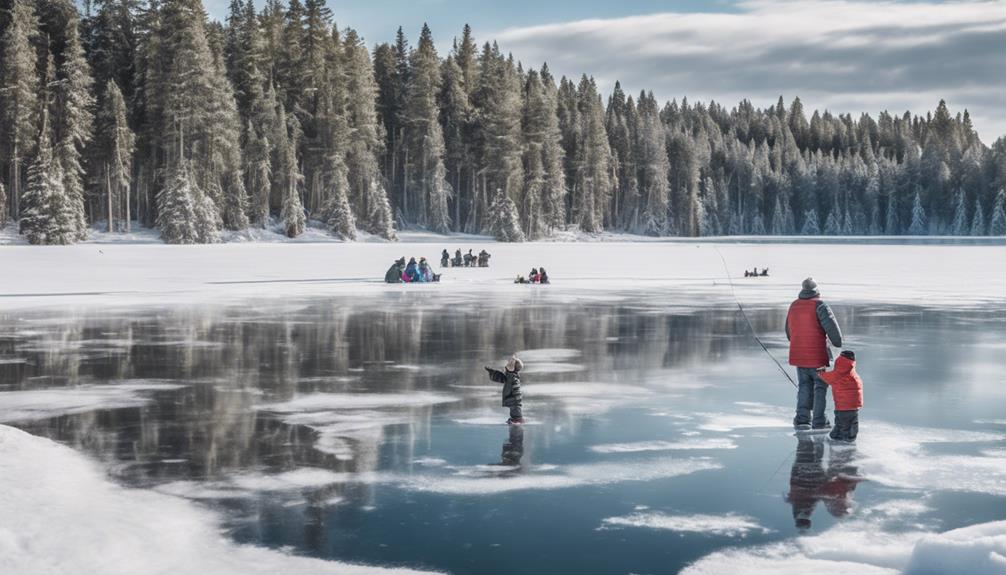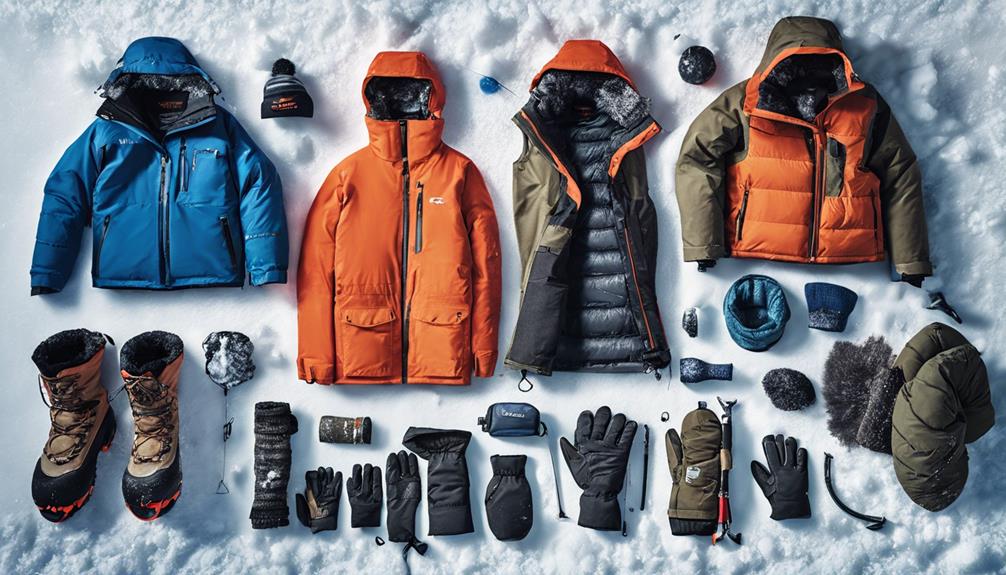Are you fully equipped for a successful ice fishing trip?
From essential tools like an ice auger to handy items like hand warmers, your tackle box should be stocked with the right gear.
But what else should you consider bringing along to ensure a productive day out on the ice?
Stay prepared and make the most of your ice fishing experience by discovering the complete list of 13 must-have items that will elevate your game in the chilling waters.
Ice Auger
When ice fishing, an essential tool to have in your tackle box is an ice auger. Proper ice auger maintenance is crucial to ensure it performs at its best when you need it most. Some of the best brands known for their durability and performance include Eskimo, Strikemaster, and Jiffy.
Choosing the right size ice auger is essential for efficiency on the ice. Consider the ice thickness you'll typically encounter; a 6 to 8-inch auger is suitable for most situations, while thicker ice may require a 10-inch auger. Additionally, selecting the appropriate blades for your ice auger is vital. Blades come in various styles, such as standard, serrated, and curved, each offering distinct advantages depending on the ice conditions.
To maintain your ice auger, clean it after each use to prevent ice buildup and corrosion. Apply a thin layer of oil to the blades and moving parts to prevent rust. Regularly sharpen the blades to ensure smooth and easy drilling through the ice. Inspect the engine and make any necessary repairs or adjustments to keep it running smoothly throughout the ice fishing season.
Tip-Ups
Properly setting up your tip-ups is essential for maximizing your ice fishing success. When it comes to tip-up maintenance, ensure your equipment is in top condition before hitting the ice. Check for any signs of wear and tear, such as frayed lines or rusty components, and make necessary replacements. Setting up tip ups correctly involves placing them strategically in areas where fish are likely to be found. Holes should be drilled at proper intervals, keeping in mind the species you're targeting.
Regularly oiling the moving parts of your tip-ups can prevent them from freezing up in the cold temperatures. It's also crucial to test your tip-ups before leaving to fish to ensure they're functioning correctly. Adjust the tension settings according to the size of the bait and the target fish species. Remember to flag your tip-ups adequately, so you can easily spot when a fish takes the bait.
When setting up multiple tip-ups, space them out to cover a larger area and increase your chances of catching fish. By maintaining your tip-ups and setting them up strategically, you'll be well-equipped to have a successful ice fishing experience.
Jigging Rod
Ensure your jigging rod is equipped with a sensitive tip to detect the subtle bites of fish beneath the ice. When selecting a jigging rod for your ice fishing adventures, keep in mind the importance of having a responsive and lightweight rod to feel even the slightest movements from below.
Here are some essential items to consider adding to your ice fishing tackle box to enhance your jigging experience:
- Rod Holder: A rod holder can be a game-changer when jigging for fish. It allows you to set your rod down securely, keeping your hands free to manage other tasks while waiting for a bite. Look for a sturdy and adjustable rod holder that can accommodate different rod sizes to ensure stability on the ice.
- Line Spooler: A line spooler is a handy tool that can help you efficiently spool new line or change line types on your jigging rod. It saves time and frustration by keeping your line organized and tangle-free, allowing you to focus on fishing rather than dealing with line management issues.
- Tangle-Free Guides: Opt for a jigging rod with tangle-free guides to prevent line snags and ensure smooth line movement during your ice fishing excursions. Tangle-free guides minimize friction, allowing your line to flow effortlessly and increasing sensitivity to detect bites promptly.
Lures and Baits
Enhance your ice fishing tackle box with a variety of lures and baits to attract and entice fish beneath the icy surface. When it comes to bait selection, consider using live bait such as minnows or waxworms, as they can be highly effective in attracting a wide range of fish species. Additionally, artificial lures like spoons, jigs, and soft plastics can mimic natural prey, making them a versatile choice for ice fishing.
To maximize your chances of success, it's crucial to familiarize yourself with different fishing techniques suited for ice fishing. Depending on the fish species you're targeting, you may need to adjust your approach. For example, if you're going after panfish, using small jigs tipped with bait can be a winning strategy. On the other hand, larger predatory fish might be more enticed by flashy spoons or swimbaits.
Ice fishing strategies play a vital role in determining your catch, and lure presentation is key. Experiment with different jigging motions to see what triggers a response from the fish. Sometimes a subtle approach works best, while other times aggressive jigging can attract more active fish. Remember to vary your presentation until you find what works best in the given conditions. By diversifying your bait selection and mastering ice fishing techniques, you'll be well-equipped to reel in some impressive catches on your next ice fishing adventure.
Ice Scoop
When preparing for ice fishing, having an ice scoop in your tackle box is essential for clearing out holes and maintaining a productive fishing environment. Here are some key points to consider:
- Ice Scoop Benefits:
An ice scoop is crucial for quickly removing ice chunks and slush from your fishing hole, allowing you to keep fishing without interruptions. It helps you maintain a clean and clear hole, ensuring better visibility and access to the water below.
- Alternatives:
While traditional ice scoops are effective, some anglers opt for lightweight collapsible shovels or even modified dustpans for clearing ice. These alternatives can offer different benefits such as portability and versatility.
- Maintenance Tips and DIY Repairs:
To keep your ice scoop in top condition, rinse it with freshwater after each use to prevent corrosion. Periodically check for any signs of wear or damage, such as bent handles or rusty spots, and address them promptly with simple DIY repairs like sanding down rust or reinforcing weak spots with epoxy.
Having an ice scoop in your tackle box ensures you can quickly and efficiently clear your fishing area, making your ice fishing experience more enjoyable and successful.
Tackle Box Organization
Organizing your tackle box efficiently is crucial for easy access to your gear and maximizing your time on the ice. To ensure you're ready for a successful ice fishing trip, here are some tackle box essentials and organization tips to consider for efficient storage and tackle box setup.
Firstly, it's essential to categorize your gear. Use small containers or resealable bags to separate different types of lures, hooks, sinkers, and other tackle items. This won't only keep your tackle box neat but also make it easier to locate specific items when needed. Additionally, consider using a tackle box with adjustable dividers or trays to customize the storage space according to your preferences.
When setting up your tackle box, place frequently used items in easily accessible compartments. Keep your go-to lures, hooks, and bait near the top for quick retrieval. Utilize the smaller sections for items like swivels, bobbers, and extra line. This setup will help you stay organized during the excitement of ice fishing and prevent you from wasting time searching for gear.
Lastly, make it a habit to clean and organize your tackle box after each ice fishing trip. Remove any damaged or rusted items, replenish used supplies, and ensure everything is in its proper place. By maintaining a well-organized tackle box, you'll be prepared for your next ice fishing adventure with ease.
Hand Warmers

To keep your hands warm and comfortable during long hours on the ice, consider including hand warmers in your ice fishing tackle box. When the temperatures drop and the icy winds blow, having the right gear can make all the difference in your fishing experience.
Here are some essential items to help you combat the cold:
- Winter Gloves: Insulated winter gloves are crucial for protecting your hands from the biting cold. Look for waterproof and windproof gloves to keep your hands dry and warm throughout your fishing trip.
- Heat Packs: Hand warmer heat packs are a convenient way to add extra warmth to your gloves. Simply activate them and slip them into your gloves for long-lasting heat that will keep your fingers nimble and responsive.
- Portable Heater: In addition to hand warmers, a portable heater can be a game-changer on especially frigid days. Place it near your fishing spot to create a cozy environment and ensure your hands stay warm and functional.
Don't forget to pair these hand-warming essentials with thermal socks to keep your feet toasty as well. By preparing with these key items, you can focus on enjoying your ice fishing adventure without being sidelined by the cold.
First Aid Kit
Consider including a compact first aid kit in your ice fishing tackle box for emergency situations on the ice. When you're out in the cold, having emergency supplies readily available can make a significant difference in handling unexpected injuries or accidents. A basic first aid kit for ice fishing should include items such as adhesive bandages, sterile gauze pads, antiseptic wipes, adhesive tape, scissors, tweezers, pain relievers, and any necessary personal medications.
Proper handling of a first aid kit involves knowing how to use its contents effectively. Familiarize yourself with the items in the kit before heading out onto the ice. Understand the purpose of each item and how to apply it in case of an emergency. Keep the first aid kit in a waterproof container to prevent its contents from getting damaged by the ice or water. Additionally, regularly check the kit to ensure that supplies are up to date and not expired.
In the event of an injury while ice fishing, having a well-equipped first aid kit can provide essential care until further help arrives. Remember that prevention is key, so always prioritize safety measures to minimize the risk of accidents. By including a first aid kit in your ice fishing gear, you're better prepared to handle unexpected situations and ensure a safer fishing experience.
Frequently Asked Questions
How Do I Choose the Best Location for Ice Fishing?
When choosing the best location for ice fishing, start by studying topographic maps to locate potential spots with varying depths and structures.
Consider using underwater cameras to scout for fish and their movements beneath the ice.
What Safety Precautions Should I Take While Ice Fishing?
When ice fishing, it is essential to prioritize safety. Know emergency procedures and always check the ice thickness before venturing out onto the frozen surface. Carry a first aid kit to be prepared for any mishaps that may occur and make sure to learn how to prevent hypothermia in the cold environment. It is crucial to always inform someone of your plans and location before heading out onto the ice. Additionally, wearing appropriate clothing and gear for the cold conditions is important to stay warm and safe. Remember, safety should always come first!
Ensure your safety by following these guidelines and being prepared for any situation that may arise while ice fishing. Stay informed and take the necessary precautions to enjoy your time on the ice safely.
Are There Any Regulations or Permits I Need to Be Aware of Before Ice Fishing?
Before heading out for ice fishing, make sure you're aware of permit requirements and licensing rules in the area. Seasonal restrictions and fishing regulations may also apply, so check with local authorities beforehand.
It's essential to follow these guidelines to ensure a safe and legal fishing experience. Be prepared and informed to avoid any issues while enjoying your time on the ice.
How Do I Properly Store My Ice Fishing Gear During the Off-Season?
When it comes to storing your ice fishing gear during the off-season, there are a few key tips to keep in mind.
Make sure to clean and dry all your equipment thoroughly before storing it. Store your gear in a cool, dry place to prevent rust and damage.
Consider using airtight containers or storage bins to keep everything organized and protected. Regularly check your gear for any signs of wear and tear to address maintenance issues promptly.
What Are Some Common Mistakes to Avoid While Ice Fishing?
When ice fishing, avoid common mistakes like not wearing proper clothing for the cold or neglecting equipment maintenance.
Dress warmly in layers, including waterproof gear.
Keep your tools in top condition by regularly checking lines, rods, and bait.
Conclusion
Now that you have all the essential items for your ice fishing tackle box, you're ready to hit the frozen waters and reel in some big catches.
Remember to stay organized, keep warm with hand warmers, and always be prepared with a first aid kit.
With these must-have items in tow, you'll have a successful and enjoyable ice fishing experience every time.
Happy fishing!



